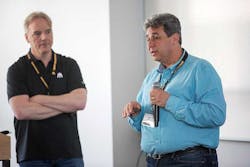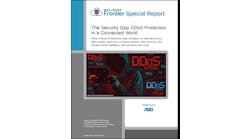Is there room in the data center industry for two open hardware movements? The infrastructure team at LinkedIn thinks so, and has created the Open19 initiative as an alternative to the Open Compute Project (OCP), the open source hardware initiative created by Facebook in 2011.
Today Open19 announced a foundation and articulated a vision to differentiate its strategy and hardware offerings. The Open19 Foundation and its founding partners positioned the project as a foundational layer of edge computing, drawing a contrast with Open Compute, whose offerings have been focused on hyperscale data centers.
GE, HP Enterprise, Flex and Vapor IO joined LinkedIn as founding members for the foundation, which is now open for contributions. Other companies aligning with the project include hardware suppliers Delta, Inspur, Cumulus Networks and Molex, along with systems integrator Groupware Technology.
“The Open19 Platform represents a simple solution for a complex problem, so it’s no surprise that the response from the community has been so strong,” said Yuval Bachar, president of the Open19 Foundation and Principal Engineer, Global Infrastructure Architecture and Strategy at LinkedIn. “With the formation of the foundation, and the addition of our new partners, we can now begin capitalizing on this interest from the community and building on the vision for the Open19 open platform.”
Looking Beyond the Hyperscale Sector
The LinkedIn team says it created Open19 to offer options beyond the Open Compute Project, particularly in making standardized solutions available to smaller data centers. Both projects emphasize rack-level design, disaggregated systems and modular integration of components.
Some companies will participate in both projects, most notably Microsoft, which has been a prominent contributor to OCP and acquired LinkedIn last year. The two organizations have thus far continued to operate their own data centers.
Bachar says Open19 is differentiated by its focus on a 19-inch rack (more on this in a moment) and licensing terms that allow participants better control over their intellectual property.
The Open19 production hardware designs are under development. “The pre-production units are currently in our labs undergoing rigorous testing and validation before we release them to final production build and to the public,” said Bachar.
While there’s no question that Open Compute has developed around the needs of hyperscale providers, that’s partly a function of trends in server and equipment sales. Hyperscale providers buy large volumes of servers, storage and network equipment, providing a ready market for vendors that develop new hardware solutions.
Bachar says Open19 will have configurations that will appeal to large data center operators, but also has the potential to create markets for open hardware in other use cases. “We believe the Open19 technology framework will be used to create new business models and optimized data center/edge ‘mini’ data center configurations,” he said.
A Platform For IoT and Edge?
The founding members of Open19 include several of the leading proponents of this type of distributed infrastructure to support edge applications, including the Internet of Things and autonomous cars.
GE said Open19 is shaping up as an important component to help standardize deployments using Predix, the company’s software management platform for the IoT.
“As a leader in the Industrial IoT, GE sees a need to establish a set of standards and customizable, flexible and economical data center designs, which will ultimately help our industrial customers capitalize on the latest advances in computing,” said Darren Haas, Head of Predix Cloud Engineering at GE Digital. “One of the benefits we see from supporting Open19 is that it allows us to drive future solutions that are optimized for industrial use cases while taking advantage of an open architecture.”
Another Open19 member focused on the edge is Vapor IO, a startup led by Cole Crawford, who was the Executive Director of the Open Compute Project from 2013-15. Vapor IO has launched a platform to enable rapid deployment of edge capacity by wireless network operators and real estate investment trusts (REIT) specializing in the telecom tower business.
“Open19 is the rack standard we’ve needed for a decade,” said Crawford. “With Open19, we can snap together Tower Edge Compute data centers like Lego bricks. We can send a crew out to an edge environment, such as at the base of a cell tower, and stand up a new data center in minutes. Interchangeable parts mean customer and field ops teams have a common interface that works regardless of the components inside the chassis.”
Components of Open19
The Open19 design is bult atop cages and bricks. Cages are enclosures that fit into a standard 19-inch rack and contain compartments for servers. The servers themselves are the “brick” components that can be stacked inside the cage in a variety of form factors.
The common components of the Open19 Foundation data center design platform. (Photo: Open19)
Open19 will allow end users to mix and match equipment from multiple vendors. An early prototype housed servers from five separate vendors.
These building blocks have the following specifications:
- Standard 19” 4-post rack
- Brick cage
- Brick (B), Double Wide Brick (DWB), Double High Brick (DHB), Double High & Wide Brick (DHWB)
- Power shelf: 12v distribution, OTS power modules with any AC or DC inputs
- Optional Battery Backup Unit (BBU)
- Networking switch (ToR)
- Snap-on power cables – up to 400w per brick, linear growth with size
- Snap-on data cables – up to 100G per brick, linear growth with size
The bricks can accommodate GPU servers as well as traditional CPU servers. The design allows for as many as 96 servers and 40kW power density per rack, but a typical four-cage setup with two power shells will run around 19.2 kW a rack.
The design could enable a “bare metal as a service” offering, in which service providers could lease capacity by the brick. An early adopter of this model will be the Lefdal Mine Datacenter, which just opened in Norway.
OCP: We Have 19-Inch Configurations
Bachar worked on the Open Compute Project during his time as a network engineer at Facebook, but said that frustrations over licensing and intellectual property convinced him that there was potential for an initiative like Open19.
“We found the environment (at Open Compute) to be problematic for a few reasons,” Bachar said last week at the Infrastructure Masons Summit in Palo Alto. “The IP rules are extremely stringent and make it difficult for suppliers to participate.”
In weighing options for open hardware, the LinkedIn team contemplated the best entry points.
“To design the type of solution we were looking for, we had to go investigate and find the common denominators of the average data center and optimize only those elements, while still creating value and differentiating technology,” said Bachar. “The common element we found was the 19-inch rack, so we decided to build a standard around 19 inch. We learned very quickly that this was applicable to other people.”
There have been some tensions between Open19 and the Open Compute Project, particularly over the notion that the OCP doesn’t support a 19-inch rack design. In 2012 the OCP introduced the Open Rack, which features a 21-inch chassis that allows more space for components and airflow, which can assist with cooling. But OCP is also supporting several designs for 19-inch racks, including the Project Olympus concept contributed by Microsoft, LinkedIn’s parent company.
In March, a photo of an Open19 rack in display on the CeBIT trade show was shared by Bachar on the OCP Facebook group, prompting a response from the Open Compute team.
“The open ecosystem is about choice and we at the Open Compute Project (OCP) Foundation believe the space in, near and around the data center space is big enough for many choices,” said Dirk Van Slyke, Director of Marketing and Communications for the Open Compute Project. “OCP offers several PROVEN choices to the open ecosystem. To infer that OCP doesn’t enable 19 inch as a choice is inaccurate and misleading on many fronts. We encourage open collaboration and would welcome a discussion with the Open19 team.”






